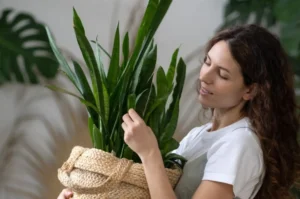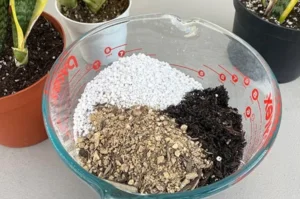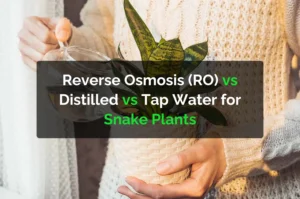Snake plants (Sansevieria), commonly known as mother-in-law’s tongue, are well-loved for their durability and easy care. These hardy houseplants adapt to various environments, making them perfect for both novice and experienced plant owners. A frequent question among plant enthusiasts is whether snake plants prefer humid conditions. Knowing how humidity influences their growth can help you cultivate a healthier plant.
Why Snake Plants Like Humidity?
Snake plants prefer moderate humidity, though they are highly adaptable to dry conditions. A humidity level of 40–50% helps prevent leaf drying and browning, supports steady growth, and mimics their native tropical habitat. It also enhances resilience against environmental stress caused by heating or air conditioning. While they don’t need high humidity, maintaining a balanced moisture level can contribute to their overall health and longevity.
The Impact of Humidity on Snake Plants
Snake plants are native to dry regions of Africa, where they have adapted to survive in arid conditions. Because of this, they prefer low to moderate humidity levels. In general, snake plants do well in indoor environments with humidity levels between 30% and 50%, which is the average humidity level found in most homes.
High humidity can create problems for snake plants. When the air is too moist, their soil may take longer to dry out, leading to root rot. Excessive moisture can also make the plant more susceptible to fungal infections and mold growth. If you live in an area with high humidity, it is essential to ensure proper ventilation and avoid overwatering your snake plant.
On the other hand, very low humidity levels are usually not a concern for snake plants. They can tolerate dry air quite well, making them a great choice for homes with air conditioning or heating systems that reduce indoor humidity. However, if the air becomes too dry, you may notice slightly curled or crispy leaf edges, which is a sign that your plant could use a bit more moisture.
Understanding Ideal Humidity Levels for Snake Plants
The ideal humidity range for snake plants is between 30% and 50%. This range mimics their natural habitat and ensures healthy growth. If the humidity level in your home is too high, consider using a dehumidifier or placing the plant in a well-ventilated room. If the humidity is too low, occasional light misting (without overdoing it) or placing a small dish of water nearby can help maintain balanced moisture levels.
How Humidity Affects Growth and Health
Humidity directly impacts the growth rate and overall health of snake plants. In environments with high humidity, these plants may grow more slowly due to excessive moisture in the soil, which can suffocate roots. In contrast, dry conditions support better root health and allow the plant to thrive. Proper watering practices and maintaining optimal humidity help prevent common issues like root rot, fungal growth, and pests.
Signs That Your Snake Plant is Affected by Humidity
Understanding the signs of humidity stress in snake plants can help you take quick action to maintain their health. If your plant is receiving too much moisture from the air, you may notice yellowing leaves and mushy or soft stems. Conversely, if the air is too dry, the leaves may start curling or developing brown tips. Mold or fungal growth on the soil surface is another indication that the surrounding air is too damp.
How to Maintain the Right Humidity for Snake Plants
Maintaining the ideal humidity level for snake plants is simple with these practical strategies. Placing the plant in a room with stable humidity and ensuring proper airflow can significantly benefit its health. Using well-draining soil is crucial, as it prevents excessive moisture retention, reducing the risk of root rot. Additionally, watering should be done only when the soil is completely dry. Keeping an indoor humidity meter can help you monitor moisture levels and make necessary adjustments accordingly.
Creating a Humidity-Friendly Plant Collection
If you love having a variety of houseplants, it’s important to consider their humidity needs. While snake plants thrive in low humidity, many tropical plants prefer higher humidity levels. To maintain a balanced environment for different plants, it is best to separate species based on their moisture requirements. Placing snake plants in drier areas of the house and grouping humidity-loving plants together ensures that all your plants remain healthy. If using a humidifier, keep snake plants at a distance to prevent excessive moisture exposure. Proper air circulation further helps in maintaining the right humidity levels for your indoor greenery.
Frequently Asked Questions (FAQs):
Can snake plants survive in a bathroom?
Yes, snake plants can survive in a bathroom, but they need good air circulation to prevent excessive moisture buildup that can lead to root rot.
How do I know if my snake plant is getting too much humidity?
Signs of too much humidity include yellowing leaves, mushy stems, or mold on the soil surface.
Can I keep a snake plant outside?
Yes, as long as the climate is warm and dry. Avoid placing it in areas with high humidity or excessive rainfall.
What happens if my snake plant is in very dry air?
In extremely dry air, the leaves may curl or develop brown tips. Providing occasional humidity through indirect means, like placing a dish of water nearby, can help maintain balance.
Conclusion
Snake plants are hardy and adaptable, making them one of the easiest houseplants to care for. While they prefer low to moderate humidity, they can tolerate various conditions as long as they are not exposed to excessive moisture. By providing well-draining soil, good airflow, and avoiding overwatering, you can ensure your snake plant remains healthy and vibrant. Whether you are a beginner or an experienced plant owner, understanding your plant’s humidity needs will help it thrive in your home.







1 thought on “Do Snake Plants Like Humidity?”
I really appreciate this post. I have been looking everywhere for this! Thank goodness I found it on Bing. You have made my day! Thank you again!